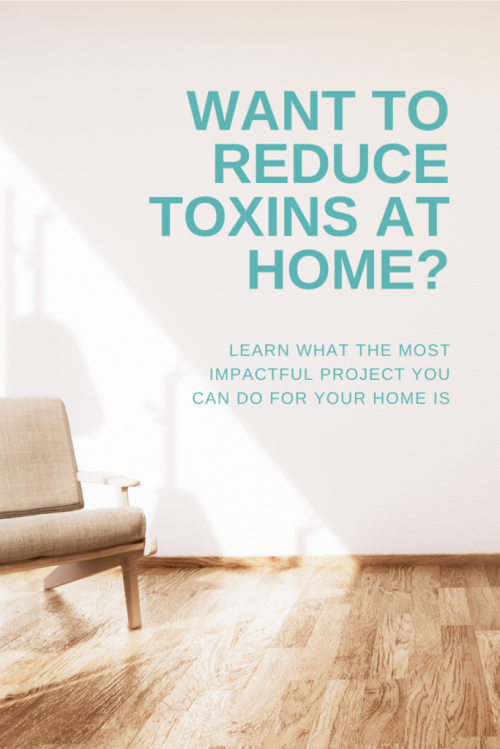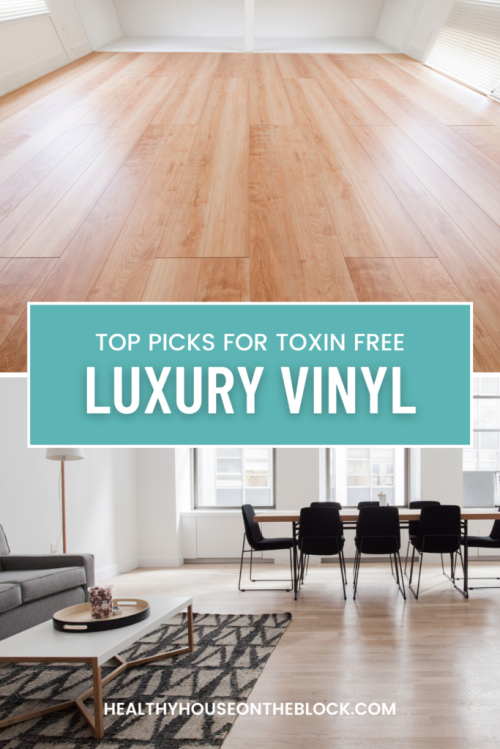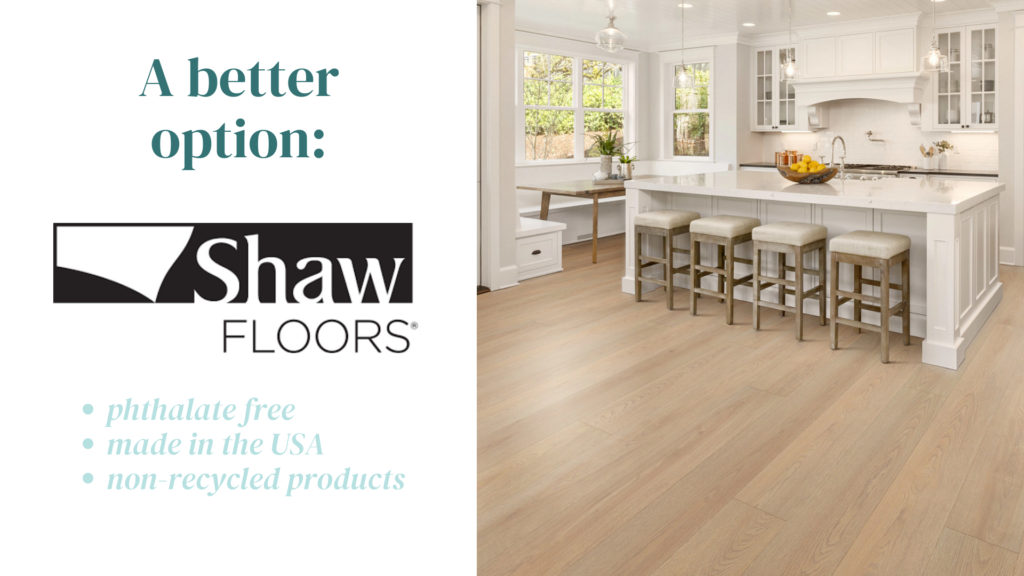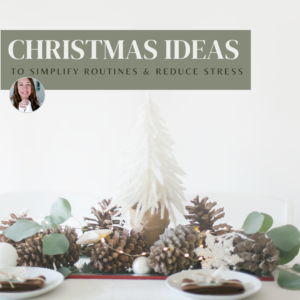
Have you ever done something and then immediately wished you had done it differently? It’s the worst feeling right off the bat. But I will say that this experience often offers a HUGE growing experience, which if nothing else, is a positive that can come from a frustrating situation. For me this happened after moving into our current home and replacing ALL the carpet with …… more toxic carpet. At the time I knew nothing about toxin free flooring or luxury vinyl plank flooring that could be low toxin. I just did what everyone else at the time did: had fresh carpet put inside my house.
Of course within a year I started studying what makes a home sick or unhealthy and one of the worst contributors to our indoor environment is carpet — especially if it was new. Of course I wasn’t going to rip it all out — we literally JUST put it in. It was one of those learning experiences where I now knew better and so I had to DO Better in the future.
Which is exactly what we’ve done. While yes, we still have the same carpet (and yes, we plan to replace it some day), other flooring that we’ve chosen in the meantime has been done with careful research into not only the toxins in the floor, but the type of room or environment we plan to use it in.
You see, not all flooring is best for every room in your home. You have to know what type of climate you’ll be installing the floor in and understand if it’s prone to humidity, if it has potential moisture intrusion, if it’s extremely dry, if it’s hot, etc. These all make a difference when choosing what type of flooring to install. And for us, in our lowest level of our Minnesota home, luxury vinyl plank flooring made the most sense to combat the moisture and humid environment of a basement.
We didn’t take this choice as lightly as we once did our carpet installation. Instead, we did our research and planned ahead, just like I teach in the Healthy Home Blueprint. And we made a better choice than before. And really, that’s about the best we can do, isn’t it? Do the best with the resources we have, the budget we have and the time we have.
FLOORING IS ONE OF THE MOST IMPACTFUL CHANGES TO A HEALTHY HOME
If you want to make a change to your home that will have a BIG impact on the health and wellness of your space, flooring is one of the biggest and best.
Flooring covers a HUGE amount of surface area in your home. This means that one of the most plentiful materials in your home is whatever you have on your floors. If there are numerous toxins in your flooring, especially those that offgas, those toxins will be in every area that your flooring is in too. So if you were to take out all of this toxic flooring and replace it with a lower toxin option, you’d just multiply it by all the square footage you’re covering. That alone makes this a high impact change
Another reason changing flooring can be so impactful is it is a HIGH touch surface area. We’re almost always touching our flooring in some way. And if you have kids, they’re touching flooring EVEN more frequently than we are. High touch areas in our home deserve our attention to make them as low toxin as possible. THESE are the areas that matter the most to our health and our wellness. Things we are touching more often mean we have a greater risk of exposing ourselves to toxins. And the less toxic a high touch area is in our home, the healthier our space will be.

WHY MOST LAMINATE FLOORING SHOULD BE AVOIDED
Just like with any man made product, there are plenty of toxins and added chemicals to luxury vinyl planking that are important to be aware of for your health’s sake.
Formaldehyde was the topic of conversation on the blog a few weeks ago. Now, its important to know that MOST luxury vinyl planks don’t contain formaldehyde anymore. HOwever, if you’re looking at a laminate flooring, these potentially have formaldehyde in the outermost layer, the layer that’s made to be super resilient and protected. FOrmaldehyde is a known carcinogen, but it also changes to the natural way cells grow and reproduce in the body. (STUDY) And a newer study shows that it can cause issues to the neurodevelopment of the brain as well as the pulmonary system. (STUDY)
Dioxins are probably the biggest concern when it comes to the toxicity of flooring. Because they are carcinogenic in nature, it obviously makes it a toxin to avoid. (STUDY) However, dioxins are also a very persistent toxin — they’re made to stick around and they certainly do. IN some cases, dioxins have been found to travel hundreds of miles, negatively impacting our water, environment and animals throughout the food chain (STUDY)
Dioxin is mainly a concern during the manufacturing of the flooring as it is a by-product of polyvinyl chloride. However, it’s important to know that it can heat inside your home from appliances, climate and living habits can cause the dioxin toxins to off-gas while in your home too.
Flame Retardants are seemingly in everything around your house when it comes to furniture and textiles. Flame retardant chemicals are present in the blood and urine of most Americans and has been linked to hormone disruption, reproductive disorders, respiratory disorders and skin issues. (STUDY ). It’s especially toxic to children as it has been shown to disrupt normal and natural development within their bodies.
Lead is one of the toxins covered in the California Prop 65 Warning. The one positive about lead is that it can not be absorbed through skin and it cannot be inhaled (unless it’s present in dust). But lead has the ability to compound in our system quite quickly because our bodies don’t detox it very quickly. This is especially true for children. Lead is a neurotoxin and negatively impacts the health of the brain and can significantly delay development in children.
Phthalates have been banned in things like children’s toys, but unfortunately, they’re still present in flooring that is produced. Phthalates are a hormone disruptor and negatively impacts the hormone cell signal pathways. Due to this disruption, other systems in the body can be negatively impacted, especially the reproductive system.
The CDC actually reported that over 90% of Americans have detectable levels of phthalates in their bodies from a variety of sources. And the group most at risk for both exposure and negative impacts to health are children. Phthalates have been tied to learning and developmental disabilities in children due to exposure.
HOW TO REDUCE TOXINS IF YOU CURRENTLY HAVE LAMINATE FLOORING
So you had laminate floors installed, or your home still has them and you’re not ready to change to a luxury vinyl plank. What can you do in the meantime? The good news is there is plenty you CAN do to reduce toxins and off gassing. REmember that most products off gas for several months up to 2 years. If the product is over 2 years old, the off gassing still does occur, but it’s much less severe.
Seal in odors with a shellac: Shellacs are a great way to seal in flooring, and they can be a wonderful way to reduce toxins that off gas as well as toxins that you can absorb by touch. You’ll obviously want to test a very inconspicuous area (or left over flooring you may have) first to ensure that the product adheres properly and that you like how it looks.
I love Vermont Natural Coating, AFM Safe Sal and ECOS Varnish for these
Keep humidity levels low: My number one rule to reduce VOCs off gassing is to keep the humidity levels low. Obviously not so low that your skin and body are suffering, but low enough to reduce the amount of VOCs that are off gassed into the air. Usually this magic number is around 35% (give or take a bit). You can use a simple hygrometer to detect your indoor humidity levels.
VOCs off gas more in humid environments, and so following this small step, you can do your home and your body a huge favor. If you’re wanting to really dive in and learn about the perfect humidity levels and how to get them in your own house, be sure to sign up for The Healthy Home Blueprint waiting list, where I have a whole module that will guide you to this achievement.
Keep temperatures low: Again, VOCs like to off gas in a warm and hot environment. The cooler your home can be, the less they will off gas into your air. Obviously we want our home to be comfortable, but if you can have it on the cooler side as well, you’ll prevent those toxins from off gassing at a higher rate in comparison. This might even be something that you need to alter or change from room to room in your home based on the direction it faces, if the door is closed frequently or if it’s near your furnace.
Lots of fresh air: One of the BEST ways you can improve your indoor air quality and reduce as many toxins as possible in your home is by simply opening a window. That’s right. It’s SIMPLE, but we forget to do it so frequently. They don’t have to be open all day long, but even opening windows for just 10-15 minutes per day is a great start. If you live in a very cold or very hot climate, this may be all you’re able to do on some days, and that’s okay. Make it a habit and get fresh air moving in and out of your home on a regular basis to allow VOC toxins to exit through your windows.

AREAS THAT LVP FLOORING IS GOOD FOR
Luxury plank vinyl is a great option for just about any area of your home, however there are some areas that it can be exceptionally good for.
Moisture Prone Lower Levels: LVP is extremely resistant to moisture and is a safe and healthy way to ensure that mold and mildew won’t take over your flooring. If you have a lower level that is prone to moisture from either humidity or flooding, luxury vinyl plank flooring is a great way to go. Make sure that you do add an appropriate underlayment to your flooring to ensure that moisture is kept away entirely.
Entry Areas: I personally love this flooring for entryways and mud rooms. Oftentimes shoes will come in with dirt on them that can scratch wood flooring and tile flooring. But luxury plank vinyl is just so resilient to scratches that it can withstand the dirt and shoes that come in on a constant basis. Add an easy to clean rug and boot tray for added help in keeping toxins and dirty out of your home.
Kitchens & Dining Rooms: One of the reasons I love this type of flooring for the kitchen and dining room is that it is SO easy to clean with a wet mop. And let’s face it. A wet mop is a must in the kitchen and in the dining room when there are families involved. I also love that oftentimes this flooring is not as hard as tile and so you won’t necessarily break a dish or glass if it gets dropped.
It can also be great because there are probably more spills and moisture in the kitchen and eating areas that the flooring can withstand beautifully.
TOXIN FREE LUXURY VINYL PLANK FLOOR OPTIONS
The beauty of the world we live in is that there are always lower toxin options that are relatively easy to find and more and more of them every day. These two LVP flooring options are as low toxin as they get while you’re still getting the benefits of a true luxury vinyl plank flooring that is easy to care for and maintenance free.
HEALTHY IDEAS FOR FLOORING INSTALLATION
Whether you’re installing flooring yourself or you’re having a professional do the work for you, it’s important to know that there are healthier ways of doing your project. You can ask your contractor about these methods or follow them yourself.
Be careful of tile demolition: If you’ll be removing flooring such as tile, PLEASE be aware that some tile can have lead in the glaze or in the interior of the product. What this means for the health of your body, is that you want to have your skin fully covered. This means using gloves, eye protection, a hat and a respiratory mask. Lead exposure can happen when dust particles are inhaled or ingested. You want to keep as much of the dust off your body as possible.
And what it means for the health of your home is that you want to avoid getting the dust anywhere it doesn’t need to be. Block off the room you’ll be working in and make sure that vents are covered to protect them from the dust getting into your HVAC system and pushing it around.
And finally, make sure the dust is cleaned up thoroughly to ensure that any potential lead is out of your home.
Wear a mask during demolition: No matter what type of flooring you’re removing, chances are there are toxins of some kind. Carpet can be one of the worst as the fibers become airborne quite quickly and you can inhale them.
Keep your lungs protected by wearing a mask of some kind to protect yourself from inhaling toxins and toxic particles while you’re removing the toxic flooring.
Seal Plywood Subfloor before installation: If at any point during your project you have your subflooring exposed, this is a GREAT time to seal in any toxins and VOCs with a VOC blocker.
AFM has created a line of products that seal in VOCs to plywood and other pressed woods. This can help reduce formaldehyde and VOC exposure in your home. Just make sure you allow enough time for the product to dry.
Dustless Install Method: One of the BEST things you can do for your home during a project is ask your contractor (or do this yourself) about a dustless install method. This means that all materials are cut outside prior to bringing them inside. This will reduce the risk of any sort of dust or toxic dust from entering your space.
The key steps to a dustless install method are to block off your space so that dust is contained to one area. You will also want to block any venting and turn off the HVAC (if possible) during the installation of the flooring. This will prevent dust from getting into areas of your home that are difficult to clean or where it can get spread around more.
And then finally, cut all materials outside and bring them inside only for the installation.
Use an underlayment in wet areas: Most LVP does not REQUIRE underlayment. However, if you’ll be adding it to a basement or lower level that can have potential moisture issues, it is important to consider underlayment as a way to prevent the flooring from becoming damaged by moisture.
Check with your flooring to see what the best underlayment option is or talk to someone at your hardware store to determine what is best for your product and home.

No matter if you’re choosing a toxin free luxury vinyl plank or if you’re just planning for the future, just remember that you’re doing your home a BIG favor by doing this high impact project. Be sure to get on the waiting list for The Healthy Home Blueprint where we cover a whole lesson of flooring and a whole module of planning ahead for your future.
Share this:
- Click to share on Facebook (Opens in new window) Facebook
- Click to share on LinkedIn (Opens in new window) LinkedIn
- Click to share on Reddit (Opens in new window) Reddit
- Click to share on Pinterest (Opens in new window) Pinterest
- Click to print (Opens in new window) Print
- Click to share on X (Opens in new window) X







Hi Amanda,
Thank you for the very informative and thorough post on Laminates!
Have you heard anything about the Mowhawk RevWood products?
Could you comment in general about testing you’ve done or heard of on any of the newer Pergo or Mowhawk laminate products?
It’s really difficult to find a clean AND affordable option that I can actually look at and purchase in my area.
thank you
Deborah
Hi Deborah — Thank you for your question! I do like RevWood for a low toxin option: It’s free from VOCs, PVCs, phthalates, asbestos, formaldehyde. I do know that it’s NALFA-certified and exceeds CARB Phase 2 and Floor Score Requirements.
Hi Amanda!
Thank you for your extensive research on the toxicity of flooring. Have you by chance heard of coretec luxury vinyl planking? They are supposed to be greenguard gold certified. What are your thoughts? Is this a good option?
Would you classify Mohawk RevWood Plus as a healthy option?
Hi Jessica! I would put it in the “good” category. It claims low emissions of VOCs and no use of PVC. However, I really like to find third party certified products, which was the thing RevWood is missing. Hope that helps!
Hi Amanda. Thanks for information about flooring. My question – is there a difference between floorscore and greenguard certified gold. What is the difference? I was considering quick step by lowe’s (Quick step Studio Glenwood Oak) and in the specifications it mentioned it had the floorscore. Can you take a closer look into it for me. I want to make sure I’m making a Healthy purchase. Thanks
Hi Judith! Floorscore only rates based on VOCs, where as GreenGuard Gold certifies extremely low levels of VOCs in a product as well as semi-VOCs like pesticides and biocides as well as other toxins like heavy metals, acids and phthalates. I wasn’t able to find any information on the flooring you were looking at that would indicate it’s a healthier option.
Hi Amanda. Ready to go with a builder who is offering Shaw Emergence Plus laminate flooring on main floor. Is this a relatively healthy option? Comes with their base package, looking to balance cost as well. Thank you.
Hi..I find you blog so helpful..so thank you. My question is have you heard of Stuga flooring. ? I tried to research it and it website says that its vinyl flooring is safe but I cannot find any research to back that up. I want to use it for my basement and laundry room. Thoughts? Thanks Lisa
Hi Amanda, my peel and stick flooring ls from home Depot. I ha noticed that a dark residue on my socks and feet has always been present no matter how many times I clean the floor. I’m concerned about this .
HI Carmen! I’m sorry to hear about that — it sounds frustrating! I’m guessing it’s the colorants used or whatever is in the top layer (also called the wear layer). It could also be that maybe the flooring was only to be cleaned with a particular solution or by a particular method? Just a few thoughts for you! Let me know if you have more questions.
Hello Amanda
We are looking to replace our 12 year old laminate click/lock floors and have been exploring both laminate and “luxury vinyl”, I noticed in one of your posts that you recommended Cali LVP as perhaps the best choice when it comes to VOCs and home health yet I have also seen that there is a class action suit against the company so my question is: are you still recommending this product?
As of right now, yes. Their products have been tested in third party chambers to ensure their off-gassing claims are true. Thanks for the question.
Hi Amanda, do you have any perspective on Home Depot’s LifeProof LVT flooring? It’s Greenguard Certified, but I can’t find much further information about it. Thank you!
Hi! I am looking to replace old carpet in my bedroom with some type of wood flooring. A friend had told me about a floating floor that interlocks so no glue used which is a plus. I also live in Minnesota. My bedroom is on 3rd level so it tends to be warmer than the lower levels. Would you recommend this type of flooring and if so what brands? I love your website. You have lots of great information .
Hi Amanda, My son and I have a chemical sensitivity and so we really wanted to get corkwood flooring in our apartment (corkwood is supposed to be quieter than hardwood and we are on an upstairs unit). We do not own the property so we told the owner we would be willing to pay for the material because we know corkwood is more expensive. the property owner said he will only install a carb 2 certified luxury vynl OR carpet. we are having breathing issues. What do you think would be better for our health both long term and short term, the luxury vynl he wants to install OR 100% wool carpet from green building supply? thank you for your time
Pingback: Flame Retardant Risks in Your Home and How to Reduce Them - Healthy House on the Block
Hello Amanda: I am needing to replace all the laminate in my home (Dining room, Living room, hallway, family room and one bedroom). I want to replace to LVT, but I also want something that is non toxic to me and my pets. What would you suggest as my best option? I have health concerns and I want to be sure I get the best flooring possible for all of us. What about painted concrete (for my downstairs areas)?
Pingback: Identify Toxic Materials: Avoiding Sick Building Syndrome
Do you know anything about the glues used for glue-down LVP or LVT? Are any of those a better choice in terms of health?
Hey Amanda, when researching Cali flooring, it states they are not phthlate free? Any info on that? Thanks!